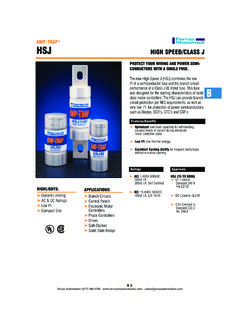Transcription of Electro-Optical Tracking Systems Considerations
1 Electro-Optical Imaging, Inc. / Electro-Optical Tracking Systems Considerations George Downey, E-O Imaging, Inc. Dr. Larry Stockum, Battelle ABSTRACT This tutorial paper discusses the performance requirements and design parameters for Electro-Optical Tracking Systems . Descriptions of Tracking Systems for range instrumentation are discussed. The relationships between the performance requirements, target characteristics and the system optical sensors, Tracking algorithms, pedestal dynamics, servo control loops, and ancillary equipment are examined. The design Considerations related to the operator interfaces are also discussed. 1. INTRODUCTION An Electro-Optical Tracking system can be viewed as having certain essential elements which can be structured in a variety of configurations to meet specific mission requirements. As a minimum, a Tracking system contains: A sensor package for detection of the target s radiated energy, a positioning system to follow the target trajectory, and a method of commanding the positioning system .
2 E-O Tracking Systems can also contain other instrumentation, such as laser rangefinders, laser radars, and range-only radars, which complement the system architecture in providing precise spatial position data. Figure 1 is a picture of the Super Radot high-precision Tracking system used in the study of reentry vehicle phenomenology [1]. The Super Radot system provides long-range position data using low light level video sensors with data recorded on videotape for post-mission data reduction. An intensified silicon intensified video camera (ISIT) is interfaced to a 60 cm aperture 600/1200 cm focal length lens. This sensor optics combination provides target ranges in excess of 800 km slant range acquisition to impact. Angular Tracking rates are one radian/sec with reduced data accuracies of 4-7 microradians in both axes. Figure 1. Super Radot Tracking system Electro-Optical Imaging, Inc. / Figure 2 is a block diagram of a fully complemented E-O Tracking system .
3 Figure 2. Tracking system Block Diagram The numerous applications for E-O Tracking Systems can be divided into five major categories as follows: Real time surveillance Homing missile guidance Laser designation Systems Weapon fire control Range instrumentation The operational requirements on an E-O Tracking system are: Target detection Target autotrack Data collection Real-time data reduction The primary performance factors are: Target characteristics Acquisition range Tracking accuracy Metric accuracy Data resolution The target characteristics which must be considered in the Tracking system are: Size Target radiance Background radiance Dynamics Range Electro-Optical Imaging, Inc.
4 / Figure 3 shows the relationship between the target and environmental parameters. Figure 3. Relationship Between Target and Environmental Parameters The target contrast, CT, is defined as BTSBTSTLLLLC+ = where L B background spectral radiance L Tb background contribution to target L S incident spectral irradiance on target L Tr reflected radiance contribution of target L Te emitted radiance contribution of target L A atmospheric transmission The following sections of the paper present a tutorial on the subsystem design factors which must be considered in configuring the Tracking system . 2. DESIGN REQUIREMENTS Subsystem Design Requirements The major subsystems in the E-O Tracking system are: (1) the sensor, (2) the gimbal system , (3) the video tracker, and (4) the gimbal control system . The design of each of these subsystems must take into account the operational mode requirements, the environment, the target characteristics, the performance requirements, the physical and cost constraints, and the data collection requirements.
5 Sensor Subsystem The sensor subsystem consists of the detector array, the optics and the sensor electronics. Imaging sensors are used in most precision Tracking applications, but single element and quadrant detector configurations are often used in missile guidance applications. Figure 4 shows the relationship between the target parameters, the environment, the optical parameters, the detector parameters, and the target voltage signal-to-noise ratio produced by the sensor. The detector and optics parameters must be selected to provide an adequate SNR to permit target detection and automatic Tracking . The key sensor parameters are the optics aperture, the optical focal length, the detector size and the detector and electronics noise and offset parameters. The sensor spectral band must be selected to permit operation in the required environment. The sensor dynamic range must permit adequate target SNR over the range of target and background radiance conditions.
6 The sensor time response and update rate must be designed in conjunction with the track loop dynamics to assure adequate target position data (in the sensor field of view) is available to the tracker and the track loop to meet the Tracking system pointing error requirements. Electro-Optical Imaging, Inc. / Figure 4. Target/Sensor system Model where LT Target radiance E( ) Radiance on detector LB Background radiance Detector X dimension TA Atmosphere transmission Detector Y dimension A Optics collecting area R( ) Detector spectral responsivity To Optics transmission VDET Detector output voltage fL Optics focal length VN( ) Detector spectral noise characteristics Important sensor characteristics are summarized as follows.
7 Spectral range Transfer Characteristics Resolution Noise Bandwidth Shading Lag Blemishes Linearity Sensitivity Blooming The following is a summary of key parameters in determining the optical system requirements: Required range Atmospherics Target size at minimum/maximum range Region of spectral interest Target contrast optical distortion Pointing accuracies Axis shift for zoom lens Electro-Optical Imaging, Inc. / Gimbal Configuration The following factors require consideration when determining the pedestal configuration. Sensor Configuration Angular Travel Azimuth and Elevation Velocity/Acceleration Resonant Frequency - Maximum Pedestal Accuracy - Minimum - Backlash Wind Loading - Static Repeatability Base Motion - True Position Accuracy The most common configuration is the elevation over azimuth yoke type with the payload mounted between the elevation structure or outboard (reference Figure 5).
8 Figure 5. Gimbal Mounting Configurations Other configurations utilize multi-axis stabilization to remove the effects of mount motion. Mirror mount Systems permit fixed payloads with the image transferred to the sensor by a moving mirror as shown in Figure 6. Figure 6. Mirror Mount system Electro-Optical Imaging, Inc. / Gimbal Control system Description The Gimbal control system positions the sensor package in response to commands from three control loops. Figure 7 shows a block diagram for the gimbal control system . Typically, the gimbal control system has a tachometer or inertial rate loop which accepts rate commands from (1) an operator, (2) a position loop, or (3) a video autotrack loop. The command source is determined by the mode of operation. Figure 7. Gimbal Control system In the Manual system , the operator positions the gimbal through a positional control (joystick) following the target s motion on a display or viewing through an optical sight.
9 The limitation of manual Systems is the operator s inability to respond to target dynamics. In a Designate system , the target s trajectory is determined from an external source such as radar or a prior knowledge of the target trajectory. This data is used to drive the gimbal s position encoders to known positions. The accuracy of this mode is determined by the Tracking accuracies of the external input or the stored trajectory data. In an Autoposition system , initial acquisition is accomplished by operator identification and selection of the target. The operator then initiates the autopositioning or autotrack mode and the Tracking processor positions the gimbal based on the calculated target position. Precise measurement of the angular portion of the line of sight is a requirement in many range instrumentation applications. The measurement accuracy is a function of the pickoff resolution and linearity, and the alignment of the pickoff to the gimbal axes. The most common types of transducers [2] are listed in Table 1, showing their relative accuracies.
10 Electro-Optical Imaging, Inc. / Table 1. Common Transducers and Their Accuracies Type Transducer Accuracy Arc Sec optical Encoders Inductosyns Multiple Speed Synchro/Resolvers High Accuracy Synchro/Resolvers Standard Synchro/Resolvers Potentiometers 1 - 2 7 20 180 - 480 480 Evaluation factors when selecting an angle transducer are: Reliability Stability Performance Static and Dynamic Mechanical Load - Repeatability Environmental Considerations - Accuracy TYPE I AND II POSITIONING Systems Gimbal Systems are typically designated Type I or Type II depending on the Tracking system requirement. A Type I servo is defined as having one integrator in the open loop characteristic, while a Type II system contains two. The choice of servo type is determined by the allowable error characteristics of the system . Type I servos yield a constant error for a constant angular rate input.




